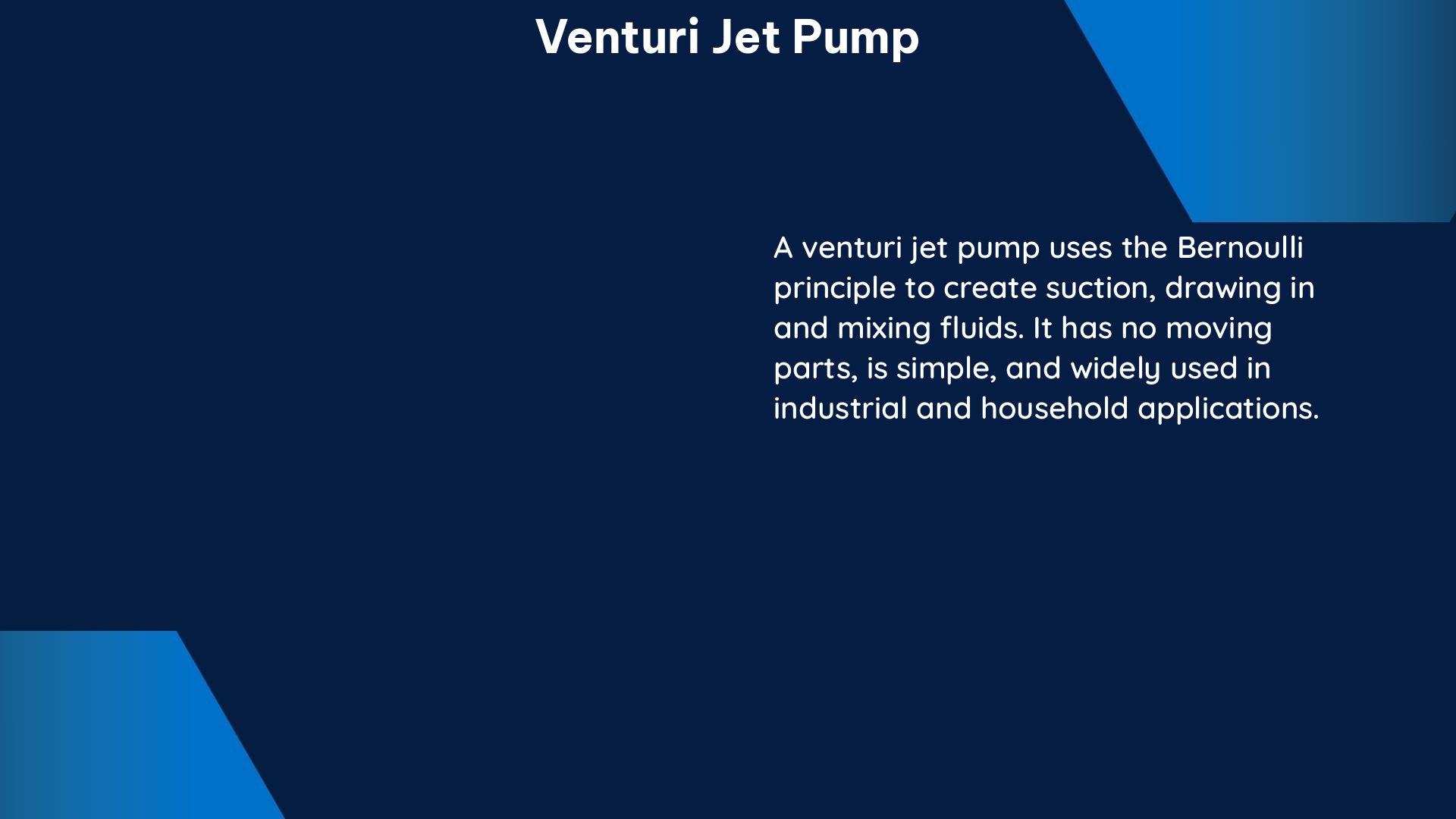The Venturi jet pump is a versatile and efficient device that utilizes the Venturi effect to create a suction force, enabling the transfer of fluids from one location to another. This comprehensive guide delves into the technical aspects of Venturi jet pumps, providing DIY enthusiasts with the knowledge and tools necessary to design, build, and optimize their own customized systems.
Understanding the Venturi Effect
The Venturi effect is the fundamental principle underlying the operation of Venturi jet pumps. When a fluid, such as air or water, flows through a constricted section of a pipe or nozzle, the fluid’s velocity increases, and its pressure decreases. This reduction in pressure creates a suction force that can be utilized to draw in and mix additional fluids, such as liquids or gases.
Evaluating Venturi Jet Pump Performance

The performance of Venturi jet pumps can be quantified using several key parameters:
- Discharge Coefficient (Cd): This dimensionless parameter represents the ratio of the actual discharge to the theoretical discharge, indicating the efficiency of the pump.
- Pressure Loss Coefficient (ζ-ratio): This coefficient measures the permanent pressure loss in the system, which is an important factor in determining the overall efficiency.
- Relative Pressure Loss: The ratio of the pressure loss coefficient to the square of the Reynolds number, providing insights into the pressure drop characteristics of the pump.
Studies have shown that the ISO-5167 Venturi, with a β-ratio (ratio of throat diameter to inlet diameter) of 0.7, exhibits excellent performance across a wide range of Reynolds numbers, from 10,000 to 10,000,000. This Venturi can also be employed for lower Reynolds numbers, from 5,000 to 10,000, with caution.
Optimizing Venturi Jet Pump Design
The efficiency of Venturi jet pumps is heavily influenced by the design of the Venturi and the diffuser. The diffuser angle is a critical geometrical parameter that affects the maximum suction lift of the pump. While the length and angle of the diffuser are difficult to quantify without experiments, studies have shown that the efficiency of the pump increases with increasing mass flow rate.
Venturi Dimensions
The dimensions of the Venturi jet pump play a crucial role in its performance:
- Inlet Diameter: Typically between 50 mm and 100 mm
- Throat Diameter: Typically between 25 mm and 50 mm
- Outlet Diameter: Typically larger than the throat diameter to allow for the increase in fluid pressure and velocity
Diffuser Design
The length and angle of the diffuser are important factors that can be customized to meet specific application needs. A well-designed diffuser can significantly improve the pump’s efficiency and suction lift.
Practical Considerations for DIY Venturi Jet Pumps
For DIY enthusiasts interested in building their own Venturi jet pumps, it is essential to consider the following factors:
- Customization: The length and angle of the diffuser, as well as the size of the Venturi, can be tailored to meet specific application requirements.
- Precision: Accurate fabrication and assembly of the Venturi jet pump components are crucial to ensure optimal performance and safety.
- Testing and Optimization: Experimental testing and iterative design modifications may be necessary to achieve the desired performance characteristics.
- Safety: Proper precautions and safety measures should be taken when operating Venturi jet pumps, especially when dealing with high-pressure fluids or hazardous materials.
By understanding the technical details and design considerations of Venturi jet pumps, DIY enthusiasts can create customized solutions that meet their specific needs, whether it’s for industrial applications, automotive systems, or even household projects.
References
- Fuel pump venturi jet – EvolutionM.net, https://www.evolutionm.net/forums/evo-x-engine-turbo-drivetrain/759097-fuel-pump-venturi-jet.html
- Design of short Venturi flow meters for incompressible and compressible fluids – NCBI, https://www.ncbi.nlm.nih.gov/pmc/articles/PMC11021958/
- Checking operation of venturi jetpump in fuel tank – 6SpeedOnline, https://www.6speedonline.com/forums/gt3-gt2/443600-checking-operation-venturi-jetpump-fuel-tank.html
- THE EFFECT OF VENTURI DESIGN ON JET PUMP PERFORMANCE – SlideShare, https://www.slideshare.net/slideshow/the-effect-of-venturi-design-on-jet-pump-performance/72736092
- Experimental and numerical studies of the jet tube based on venturi effect – ResearchGate, https://www.researchgate.net/publication/266976480_Experimental_and_numerical_studies_of_the_jet_tube_based_on_venturi_effect

The lambdageeks.com Core SME Team is a group of experienced subject matter experts from diverse scientific and technical fields including Physics, Chemistry, Technology,Electronics & Electrical Engineering, Automotive, Mechanical Engineering. Our team collaborates to create high-quality, well-researched articles on a wide range of science and technology topics for the lambdageeks.com website.
All Our Senior SME are having more than 7 Years of experience in the respective fields . They are either Working Industry Professionals or assocaited With different Universities. Refer Our Authors Page to get to know About our Core SMEs.